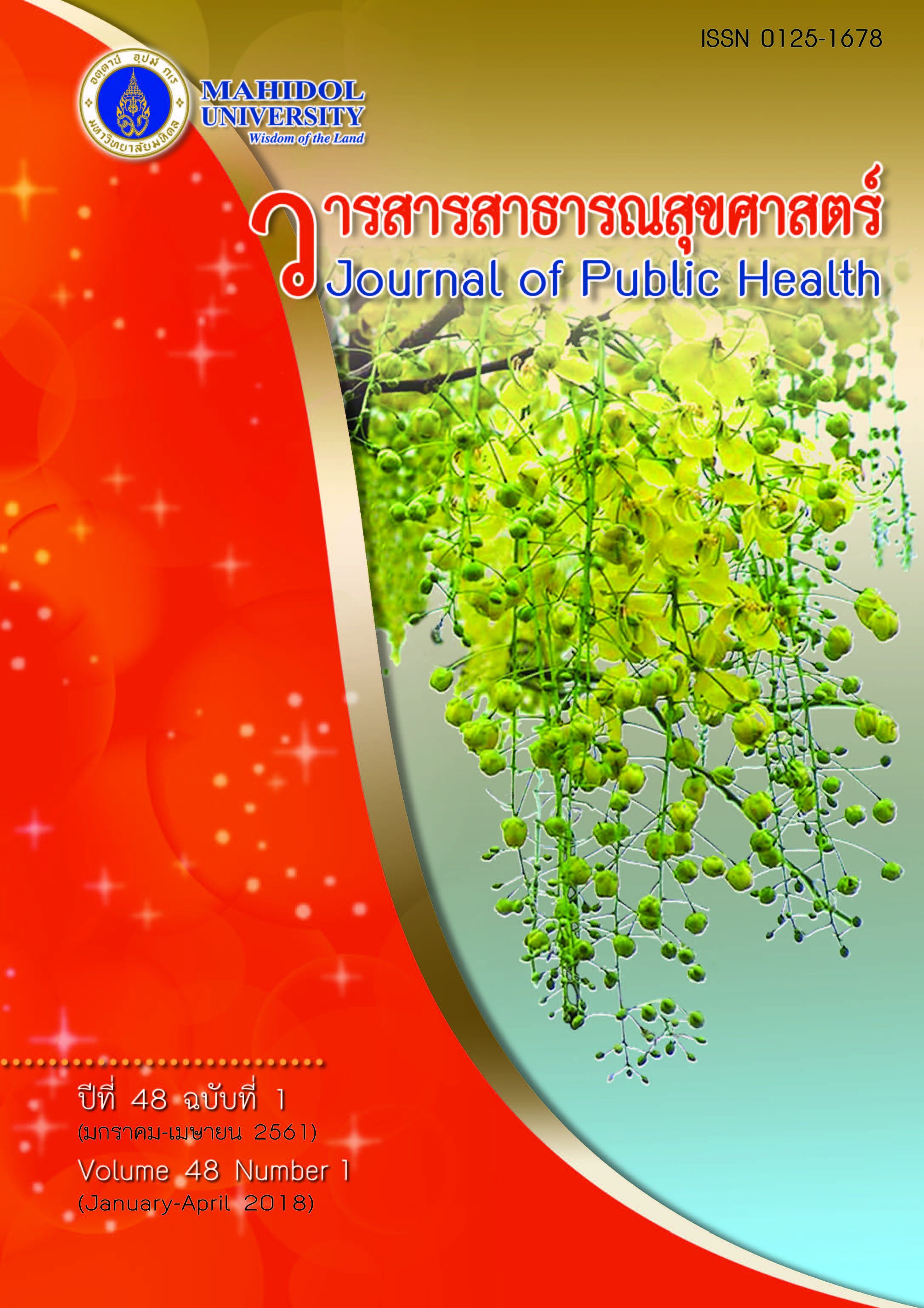การเกิดร่อง และขนาดของร่องที่พบได้จากการตรวจสมรรถภาพการได้ยินประจำปีของพนักงานจากสถานประกอบการ 9 แห่งในจังหวัดระยอง ประเทศไทย
Keywords:
เกณฑ์การเกิดร่อง, ขนาดของร่อง, การสูญเสียการได้ยินจากสียงดัง, notch criteria, notch area, noise-induced hearing lossAbstract
การศึกษาพรรณนาภาคตัดขวางนี้มีวัตถุประสงค์เพื่ออธิบายการเกิดร่อง และขนาดของร่องในผลตรวจการได้ยินของกลุ่มประชากรเป้าหมาย 1,122 ราย จากสถานประกอบการอุตสาหกรรมสารเคมี 9 แห่งในจังหวัดระยอง ประเทศไทย ผู้วิจัยใช้เกณฑ์การเกิดร่องที่ได้จากการศึกษาวิจัยก่อนหน้าเพื่อบ่งชี้การเกิดร่อง ลักษณะการเกิดร่องทั้งร่องความถี่เดียวหรือร่องหลายความถี่ และคำนวณหาขนาดของร่อง (Notch Area) ผลการศึกษาพบความชุกของร่องมากที่สุดที่ความถี่ 6,000, 4,000 และ 3,000 เฮิร์ตซ์ ตามลำดับ ส่วนใหญ่เป็นร่องความถี่เดียว ขนาดของร่องที่หูข้างขวาและซ้ายเฉลี่ย 17.7 และ 21.0 ตารางหน่วย ตามลำดับ กรณีที่เกิดร่องในหูทั้งสองข้างพบว่าขนาดของร่องระหว่างหูทั้งสองข้างแตกต่างกันเฉลี่ย 19.4 ตารางหน่วย ข้อมูลขนาดของร่องที่ได้จากงานวิจัยนี้สามารถใช้เป็นแนวทางประเมินความใกล้เคียงกันของการสูญเสียการได้ยินของหูแต่ละข้าง (Symmetrical) ซึ่งเป็นขั้นตอนสำคัญสำหรับแพทย์อาชีวเวชศาสตร์ในการวินิจฉัยว่า เป็นโรคที่เกี่ยวเนื่องจากการทำงานโดยการเกิดร่องช่วยให้แน่ใจว่าการได้ยินที่ผิดปกติไม่ได้เกิดจากอายุและขนาดของร่องที่ใกล้เคียงกันแสดงว่า เกิดจากการสัมผัสเสียงที่ใกล้เคียงกันของหูทั้งสองข้าง และควรพิจารณาทำการศึกษาต่อยอดแสดงขนาดของร่องที่เปลี่ยนแปลงไปตามระยะเวลาการสัมผัสเสียงดัง (Gradual Onset)
The Presence of Notch Shape and Notch Area Observed in Annual Audiometric Test of Employees from 9 Factories in Rayong Province, Thailand
The purpose of this descriptive cross-sectional study was to describe Notch Shape and Notch Area in a target population, 1,122 employees among 9 chemical factories in Rayong Province, Thailand. Researchers used criteria concluded from a related study to identify Notch, Notch characteristics (V-shape Notch or U-shape Notch) and calculate Notch Area. The results showed that 6,000 Hertz Notch exhibited the highest prevalence among the sample population followed by 4,000 and 3,000 Hertz Notch. The V-Shape Notch was more common than the U-shape Notch. The mean notch area in the right and left ears were 17.7 and 21.0 sq units, respectively. Among employees with a bilateral notch, mean difference of notch area between right and left ears was 19.4. Information of Notch Area from this study was useful to identify symmetrical characteristics of hearing loss, which is a crucial step for making diagnosis of work related noise-induced hearing loss (NIHL) by Occupational Medicine Physician. The presence of a Notch helps exclude presbycusis. Nearly equal dimensions of Notch Area demonstrated a similar dose response relationship of noise exposure in left and right ears. Further studies should be conducted to show how Notch Area may change gradually after noise exposure (Gradual Onset).
Downloads
Published
Issue
Section
License
Creative Commons License CC-BY-ND


